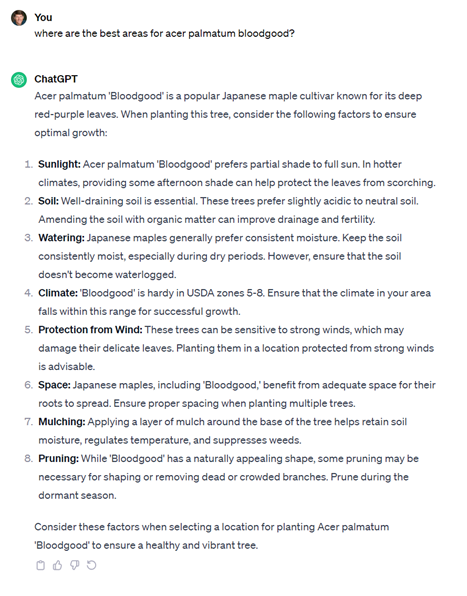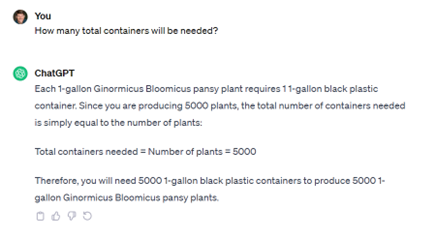Can ChatGPT Run Your Greenhouse Operation? Get Some Answers Here
In my previous article on ChatGPT, we saw many of the exciting capabilities and a few of the realistic risks this technology poses. We also discussed some of the possible applications for growers of this new advancement in artificial intelligence.
As a reminder, ChatGPT is an artificial intelligence chat bot (software program) that specializes in answering natural language-based queries which makes it an appealing interface for many tasks.
In my experiments with ChatGPT (also with Google’s competing product, BARD) I have found that for getting basic information it can be pretty good.
For example, this generic question about ‘Acer Palmatum’ to ChatGPT:

You can see that it can synthesize, from its trained content, generally good, basic consumer level information and does so mostly consistently. So, when the internet content used for training is good and accurate, the answers follow. The old saying “garbage in, garbage out” applies to the training of artificial intelligence as well. Keep that in mind.
ChatGPT can write business letter drafts, stories, poetry, software code, excel macros or suggest ways of improving existing writing to name just a few creative tasks I have witnessed it handle.
With all the positive interactions I have used it for and all the positive press these tools are getting, it seemed natural to me to ask “Can ChatGPT run a grower operation?”
So, I decided to test it with some typical scenarios that growers face regularly and see if its output was correct.
In my testing, I noticed ChatGPT runs into problems with more complex word problems that intermingle numbers, words, and implied mathematical operations or overlay serial time dependency calculations. In other words, the type of problems that growers deal with every day.
Let’s analyze the output from just one of these types of problems. Here is a simple example of a production-related question I asked ChatGPT.

Note: ChatGPT will show its steps, which is a nice way to see how it works out the problem. You can specify that you just want the output in some format (like a table) and it will skip the background.
So, regarding our simple production problem let’s check the answers. First the labor and time side.

You can see that ChatGPT got several things right but was confused on how to calculate the total wall clock hours needed to do production. ChatGPT assumed that each person was doing both operations of filling and sticking the plugs, thus yielding two units for every 30 seconds I specified in my prompt. However, in real life it is more likely (and my intent) that a person was filling the container with soil, and then a person was sticking the plugs – a typical serial dependency arrangement on many production lines. This means one unit could be produced in 30 seconds, not 15 seconds as ChatGPT assumed. Note: 30 seconds is just a number I picked for this example – your number or production line dependencies and timing may vary.
You can argue that ChatGPT was right in one interpretation of language of the prompt I gave it, which is slightly ambiguous. My problem statement to ChatGPT assumed that it “knew” how Johnny Plant Farm* produced our 1-gallon plants, that we had a soil filler person then a plug transplant person. A new employee trainee would know that by simply touring the working production line. ChatGPT does not, and as such has to be told explicitly.
This result shows one example of the importance of what is referred to as “prompt engineering” – that is, the art of structuring the language in your query with enough detail and specificity to get the desired output from the chat bot.
Like dealing with a new employee trainee, you must be careful to state the problem specifically and correctly and diligently check the answers when they are given instructions until they learn your system and methods.
Now let’s look at the raw material side of our problem.

For the raw materials, ChatGPT did better. However, even though I specified in my prompt the number of containers per unit, it didn’t total those up despite having in the prompt to “how much total raw materials will I need” given. ChatGPT did get the rest of the interpretation of raw materials and the total amounts correct, however.
When I ask a follow-up question about the amount of containers, it nails it:

Granted, the production prompt I gave it is a very simplistic one and thus straightforward to solve for almost anyone with any experience at all in our industry.
I have asked ChatGPT questions regarding multi-step production plan items that include self-propagation and bumping, including grow time scheduling. I have asked it questions about product costing and forecasting as well, trying to mimic the daily issues growers face.
I have found it can be hard to get the prompts engineered with enough detail and specificity to get what you know to be the correct answers, especially when adding in multiple periods of grow time for propagation trays and bump sizes or multiple layers of costing calculation. You must keep re-stating or clarifying the prompts/questions/details, sometimes many times, to get the intricate math/scheduling/step by step issues worked out. I will admit this repetition can start to yield feelings of “oh I will just do it myself and it will be faster”, for complex situations.
So, what’s the answer to the question “can ChatGPT run your operation?”. Well, based on the results of our simple test the answer is no, it can’t. Not yet. But it’s learning.
While ChatGPT is not a drop-in replacement for a good grower staff, the technology behind tools like ChatGPT is an astounding leap forward and will provide many ways of augmenting employee capability as we go forward.
Our growers sometimes deal with hundreds or thousands of SKUs and production runs in a season. You can see how laborious it would be to ask all those questions to get a whole season’s worth of production planning done by a tool like ChatGPT**.
Further, the complexity of our industry coupled with large and varied data sets that are not part of the training corpus of a tool like ChatGPT means there is much about your operation that ChatGPT does not have access to. And the lack of that detail is apparent in the answers it gives, especially for more complex multi-step, multi-time period scenarios.
I believe that the ChatGPT-like tools will continue to accelerate in use for many industries and job types where the language-based information synthesis capabilities of these tools are best seen and used as force multipliers for areas such as sales, marketing, research, image analysis, and similar content analysis and creation heavy job functions. New adjunct models and add-in tools allow ChatGPT-like tools to help with image, audio, and video generation as well.
While the development of new tools to add private data augmentation to an existing model like ChatGPT is advancing rapidly, it is not in the state in terms of security and raw database data to be a bridge to the complex operational world and large data volumes grower manage now.
Growers: your job is safe … for now.
*Johnny Plant Farm and Nursery is my fictitious nursery in the fictitious town of Redstone, TX, I use for real-world illustrative data examples for our growers.
**There are new software tools/platforms and APIs to programmatically interface and integrate with ChatGPT and other tools like it to speed the prompt interactions.









